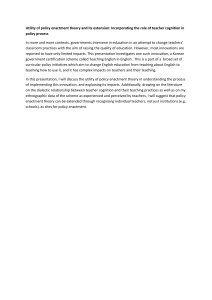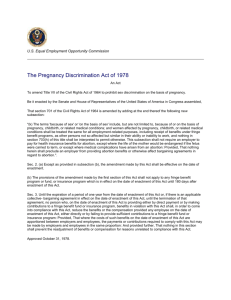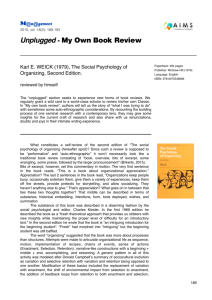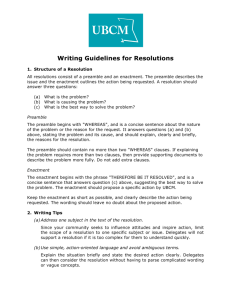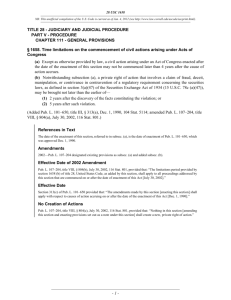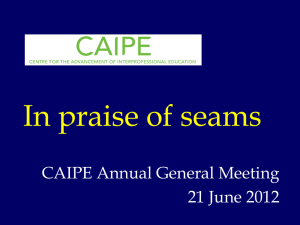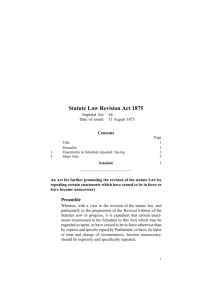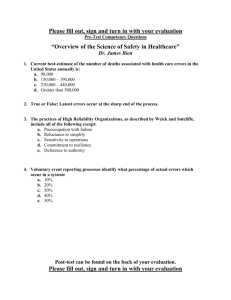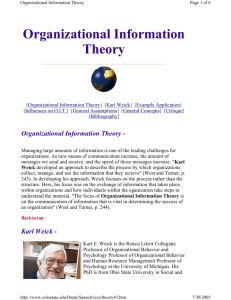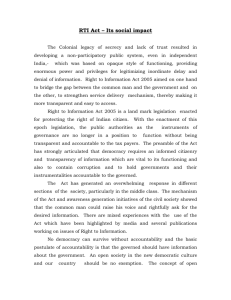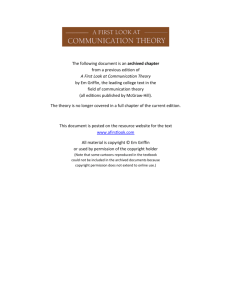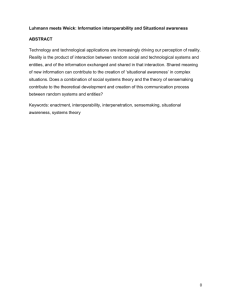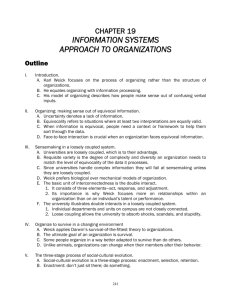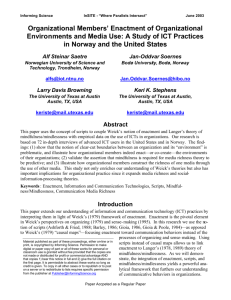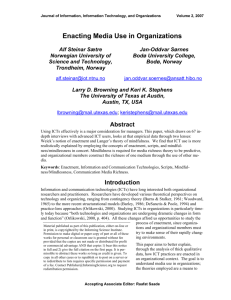Enactment Theory
advertisement
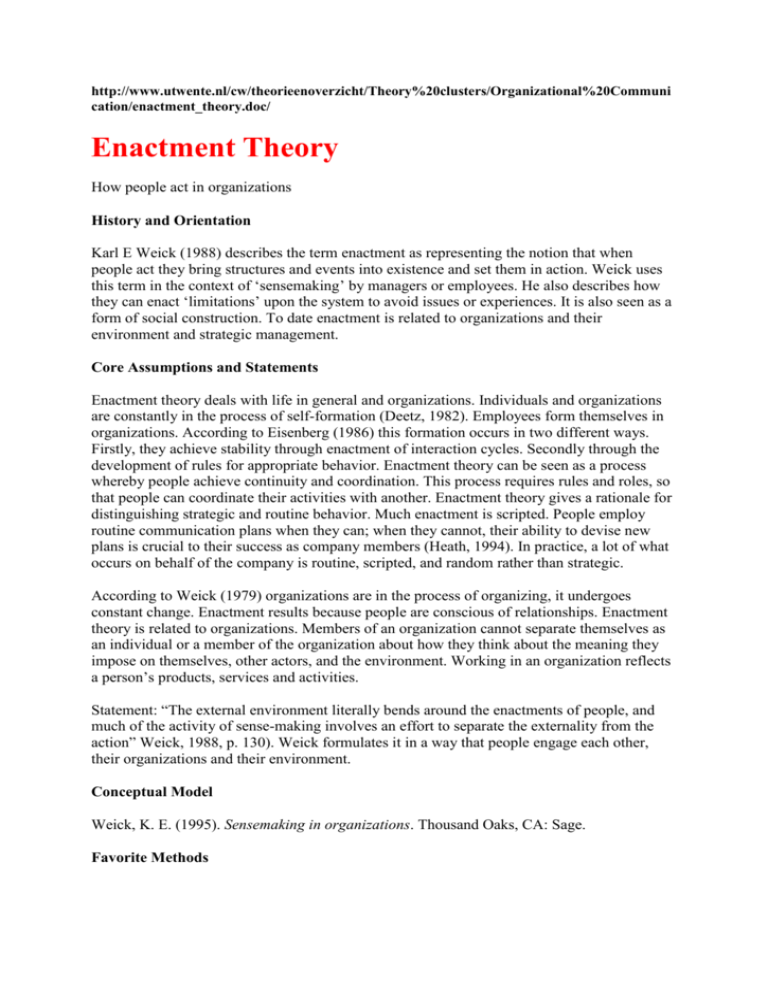
http://www.utwente.nl/cw/theorieenoverzicht/Theory%20clusters/Organizational%20Communi cation/enactment_theory.doc/ Enactment Theory How people act in organizations History and Orientation Karl E Weick (1988) describes the term enactment as representing the notion that when people act they bring structures and events into existence and set them in action. Weick uses this term in the context of ‘sensemaking’ by managers or employees. He also describes how they can enact ‘limitations’ upon the system to avoid issues or experiences. It is also seen as a form of social construction. To date enactment is related to organizations and their environment and strategic management. Core Assumptions and Statements Enactment theory deals with life in general and organizations. Individuals and organizations are constantly in the process of self-formation (Deetz, 1982). Employees form themselves in organizations. According to Eisenberg (1986) this formation occurs in two different ways. Firstly, they achieve stability through enactment of interaction cycles. Secondly through the development of rules for appropriate behavior. Enactment theory can be seen as a process whereby people achieve continuity and coordination. This process requires rules and roles, so that people can coordinate their activities with another. Enactment theory gives a rationale for distinguishing strategic and routine behavior. Much enactment is scripted. People employ routine communication plans when they can; when they cannot, their ability to devise new plans is crucial to their success as company members (Heath, 1994). In practice, a lot of what occurs on behalf of the company is routine, scripted, and random rather than strategic. According to Weick (1979) organizations are in the process of organizing, it undergoes constant change. Enactment results because people are conscious of relationships. Enactment theory is related to organizations. Members of an organization cannot separate themselves as an individual or a member of the organization about how they think about the meaning they impose on themselves, other actors, and the environment. Working in an organization reflects a person’s products, services and activities. Statement: “The external environment literally bends around the enactments of people, and much of the activity of sense-making involves an effort to separate the externality from the action” Weick, 1988, p. 130). Weick formulates it in a way that people engage each other, their organizations and their environment. Conceptual Model Weick, K. E. (1995). Sensemaking in organizations. Thousand Oaks, CA: Sage. Favorite Methods Qualitative methods, such as dialogue and discourse analysis are used. Dialogue strives for a balance between individual autonomy and organizational constraint through incorporating diverse voices (see f.e. Eisenberg).Discourse refers to language, grammars, and discursive acts that form the foundation of both performance and voice. Analysis of consultation between management groups is another method that can be used. With storytelling the impact (in focus groups) can be measured. Scope and Application Enactment can help identifying the structure of an organization. Relevant for research are interpersonal, groups and organizations. The communication structure of organizations can be studied. The communication structure is the most important predictor of informal networks. The predictor can be used in relation of the duration of networks and the strength/ weakness they have. Example See Eisenberg. References Key publications Heath, R.L. & Bryant, J. (2000). Human Communication Theory and Research. Concept, Context and Challenges. Mahwah, NJ: Erlbaum. Heath, R.L. (1994). Management of Corporate Communication. From interpersonal contacts to external affairs. Hillsdale, NJ: Erlbaum. Salem, P. (ed.) (1999). Organizational Communication and Change. Cresskill, NJ: Hampton Press. Mahling, D.E. (1993). Enactment theory as a paradigm for enabling flexible workflows. ACM Press, New York: NY. Weick, K.E. (1979a). Cognitive processes in organization. In B.M. Staw (Ed.), Research in organizational behavior. (Vol. 1, pp. 41-74). Greenwich, CT: JAI Press. Weick, K.E. (1979b). The social psychology of organizing (2nd ed.) Reading, MA: AddisonWesley. Putnam, L.L. (1989). Negotiating as organizing: Two levels within the Weickian model. Communication Studies, 40, 249-257. Putnam, L.L. & Cheney, G. (1983). A critical review of the research traditions in organizational communication. In M.S. Mander (Ed.), Communication in transition. (pp.206244). New York: Praeger. Putnam, L.L. & Mumby, D.K. (1993). Organizations, emotion and the myth of rationality. In S.Fineman (Ed.), Emotions in organizations (pp.36-57). London:Sage. Eisenberg, E.M. & Goodall, H.L. (1997). Organizational Communication: Balancing creativity and constraint (2nd ed.) New York: St.Martin’s Press. Eisenberg, E.M. (1994). Dialogue as democratic discourse: Affirming Harrison. In S.A. Deetz (Ed.), Communication yearbook 17 (pp.275-284). Thousand Oaks, CA: Sage. Miller, K. (1995). Organizational Communication: Approaches and processes. Belmont, CA: Wadsworth. Bantz, C.R. (1989). Organizing and The Social Psychology of Organizing. Communication Studies, 40, 231-240. Vallacher, R.R. & Wegner, D.M. (1985). A theory of action identification. Lawrence Erlbaum Associates, 1985. Frese, M. & Sabini, J. Goal Directed Behavior: The concept of Action in Psychology. Lawrence Erlbaum Associates, 1985. See also: Network analysis in organizations, Sensemaking See also Organizational Communication
